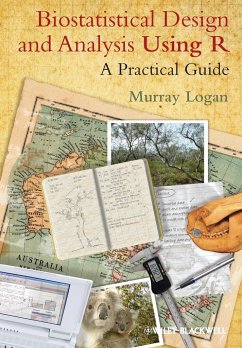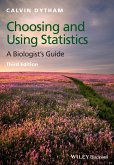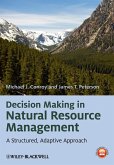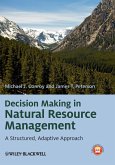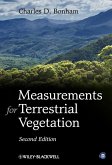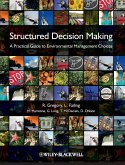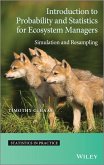Murray Logan
Biostatistical Design and Anal
Murray Logan
Biostatistical Design and Anal
- Broschiertes Buch
- Merkliste
- Auf die Merkliste
- Bewerten Bewerten
- Teilen
- Produkt teilen
- Produkterinnerung
- Produkterinnerung
R -- the statistical and graphical environment is rapidly emerging as an important set of teaching and research tools for biologists. This book draws upon the popularity and free availability of R to couple the theory and practice of biostatistics into a single treatment, so as to provide a textbook for biologists learning statistics, R, or both. An abridged description of biostatistical principles and analysis sequence keys are combined together with worked examples of the practical use of R into a complete practical guide to designing and analyzing real biological research.
Topics covered…mehr
Andere Kunden interessierten sich auch für
![Choosing and Using Statistics Choosing and Using Statistics]() Calvin DythamChoosing and Using Statistics40,99 €
Calvin DythamChoosing and Using Statistics40,99 €![Decision Making in Natural Resource Management Decision Making in Natural Resource Management]() Michael J. ConroyDecision Making in Natural Resource Management146,99 €
Michael J. ConroyDecision Making in Natural Resource Management146,99 €![Decision Making Natural Resour Decision Making Natural Resour]() Michael J. ConroyDecision Making Natural Resour113,99 €
Michael J. ConroyDecision Making Natural Resour113,99 €![Measurements for Terrestrial Vegetation Measurements for Terrestrial Vegetation]() Charles D. BonhamMeasurements for Terrestrial Vegetation106,99 €
Charles D. BonhamMeasurements for Terrestrial Vegetation106,99 €![An Introduction to Mathematical Models in Ecology and Evolution An Introduction to Mathematical Models in Ecology and Evolution]() Mike GillmanAn Introduction to Mathematical Models in Ecology and Evolution135,99 €
Mike GillmanAn Introduction to Mathematical Models in Ecology and Evolution135,99 €![Structured Decision Making Structured Decision Making]() Robin GregoryStructured Decision Making190,99 €
Robin GregoryStructured Decision Making190,99 €![Introduction to Probability and Statistics for Ecosystem Managers Introduction to Probability and Statistics for Ecosystem Managers]() Timothy C. HaasIntroduction to Probability and Statistics for Ecosystem Managers96,99 €
Timothy C. HaasIntroduction to Probability and Statistics for Ecosystem Managers96,99 €-
-
-
R -- the statistical and graphical environment is rapidly emerging as an important set of teaching and research tools for biologists. This book draws upon the popularity and free availability of R to couple the theory and practice of biostatistics into a single treatment, so as to provide a textbook for biologists learning statistics, R, or both. An abridged description of biostatistical principles and analysis sequence keys are combined together with worked examples of the practical use of R into a complete practical guide to designing and analyzing real biological research.
Topics covered include:
simple hypothesis testing, graphing
exploratory data analysis and graphical summaries
regression (linear, multi and non-linear)
simple and complex ANOVA and ANCOVA designs (including nested, factorial, blocking, spit-plot and repeated measures)
frequency analysis and generalized linear models.
Linear mixed effects modeling is also incorporated extensively throughout as an alternative to traditional modeling techniques.
The book is accompanied by a companion website www.wiley.com/go/logan/r with an extensive set of resources comprising all R scripts and data sets used in the book, additional worked examples, the biology package, and other instructional materials and links.
Hinweis: Dieser Artikel kann nur an eine deutsche Lieferadresse ausgeliefert werden.
Topics covered include:
simple hypothesis testing, graphing
exploratory data analysis and graphical summaries
regression (linear, multi and non-linear)
simple and complex ANOVA and ANCOVA designs (including nested, factorial, blocking, spit-plot and repeated measures)
frequency analysis and generalized linear models.
Linear mixed effects modeling is also incorporated extensively throughout as an alternative to traditional modeling techniques.
The book is accompanied by a companion website www.wiley.com/go/logan/r with an extensive set of resources comprising all R scripts and data sets used in the book, additional worked examples, the biology package, and other instructional materials and links.
Hinweis: Dieser Artikel kann nur an eine deutsche Lieferadresse ausgeliefert werden.
Produktdetails
- Produktdetails
- Verlag: Wiley & Sons
- 1. Auflage
- Seitenzahl: 576
- Erscheinungstermin: 10. Mai 2010
- Englisch
- Abmessung: 244mm x 170mm x 31mm
- Gewicht: 986g
- ISBN-13: 9781405190084
- ISBN-10: 1405190086
- Artikelnr.: 28707820
- Herstellerkennzeichnung
- Libri GmbH
- Europaallee 1
- 36244 Bad Hersfeld
- gpsr@libri.de
- Verlag: Wiley & Sons
- 1. Auflage
- Seitenzahl: 576
- Erscheinungstermin: 10. Mai 2010
- Englisch
- Abmessung: 244mm x 170mm x 31mm
- Gewicht: 986g
- ISBN-13: 9781405190084
- ISBN-10: 1405190086
- Artikelnr.: 28707820
- Herstellerkennzeichnung
- Libri GmbH
- Europaallee 1
- 36244 Bad Hersfeld
- gpsr@libri.de
Murray Logan is a lecturer and researcher in the School of Biological Sciences, Monash University, Melbourne, Australia. He teaches a range of zoological and ecological courses in addition to biostatistical and R courses to undergraduate and graduate students. He also provides research design and analysis advice to a range of university, government and private organizations.
Preface xv R quick reference card xix General key to statistical methods xxvii 1 Introduction to R 1 1.1 Why R? 1 1.2 Installing R 2 1.2.1 Windows 2 1.2.2 Unix/Linux 2 1.2.3 MacOSX 3 1.3 The R environment 3 1.3.1 The console (command line) 4 1.4 Object names 4 1.5 Expressions, Assignment and Arithmetic 5 1.6 R Sessions and workspaces 6 1.6.1 Cleaning up 6 1.6.2 Workspaces 7 1.6.3 Current working directory 7 1.6.4 Quitting R 8 1.7 Getting help 8 1.8 Functions 9 1.9 Precedence 10 1.10 Vectors - variables 11 1.10.1 Regular or patterned sequences 12 1.10.2 Character vectors 13 1.10.3 Factors 15 1.11 Matrices, lists and data frames 16 1.11.1 Matrices 16 1.11.2 Lists 17 1.11.3 Data frames - data sets 18 1.12 Object information and conversion 18 1.12.1 Object information 18 1.12.2 Object conversion 20 1.13 Indexing vectors, matrices and lists 20 1.13.1 Vector indexing 21 1.13.2 Matrix indexing 22 1.13.3 List indexing 23 1.14 Pattern matching and replacement (character search and replace) 24 1.14.1 grep - pattern searching 24 1.14.2 regexpr - position and length of match 25 1.14.3 gsub - pattern replacement 26 1.15 Data manipulation 26 1.15.1 Sorting 26 1.15.2 Formatting data 27 1.16 Functions that perform other functions repeatedly 28 1.16.1 Along matrix margins 29 1.16.2 By factorial groups 30 1.16.3 By objects 30 1.17 Programming in R 30 1.17.1 Grouped expressions 31 1.17.2 Conditional execution - if and ifelse 31 1.17.3 Repeated execution - looping 32 1.17.4 Writing functions 34 1.18 An introduction to the R graphical environment 35 1.18.1 The plot() function 36 1.18.2 Graphical devices 39 1.18.3 Multiple graphics devices 40 1.19 Packages 42 1.19.1 Manual package management 42 1.19.2 Loading packages 45 1.20 Working with scripts 45 1.21 Citing R in publications 46 1.22 Further reading 47 2 Datasets 48 2.1 Constructing data frames 48 2.2 Reviewingadataframe-fix() 49 2.3 Importing (reading) data 50 2.3.1 Import from text file 50 2.3.2 Importing from the clipboard 51 2.3.3 Import from other software 51 2.4 Exporting (writing) data 52 2.5 Saving and loading of R objects 53 2.6 Data frame vectors 54 2.6.1 Factor levels 54 2.7 Manipulating data sets 56 2.7.1 Subsets of data frames - data frame indexing 56 2.7.2 The %in% matching operator 57 2.7.3 Pivot tables and aggregating datasets 58 2.7.4 Sorting datasets 58 2.7.5 Accessing and evaluating expressions within the context of a dataframe 59 2.7.6 Reshaping dataframes 59 2.8 Dummy data sets - generating random data 62 3 Introductory Statistical Principles 65 3.1 Distributions 66 3.1.1 The normal distribution 67 3.1.2 Log-normal distribution 68 3.2 Scale transformations 68 3.3 Measures of location 69 3.4 Measures of dispersion and variability 70 3.5 Measures of the precision of estimates - standard errors and confidence intervals 71 3.6 Degrees of freedom 73 3.7 Methods of estimation 73 3.7.1 Least squares (LS) 73 3.7.2 Maximum likelihood (ML) 74 3.8 Outliers 75 3.9 Further reading 75 4 Sampling and Experimental Design with R 76 4.1 Random sampling 76 4.2 Experimental design 83 4.2.1 Fully randomized treatment allocation 83 4.2.2 Randomized complete block treatment allocation 84 5 Graphical Data Presentation 85 5.1 The plot() function 86 5.1.1 The type parameter 86 5.1.2 The xlim and ylim parameters 87 5.1.3 The xlab and ylab parameters 88 5.1.4 The axes and ann parameters 88 5.1.5 The log parameter 88 5.2 Graphical Parameters 89 5.2.1 Plot dimensional and layout parameters 90 5.2.2 Axis characteristics 92 5.2.3 Character sizes 93 5.2.4 Line characteristics 93 5.2.5 Plotting character parameter - pch 93 5.2.6 Fonts 96 5.2.7 Text orientation and justification 98 5.2.8 Colors 98 5.3 Enhancing and customizing plots with low-level plotting functions 99 5.3.1 Adding points - points() 99 5.3.2 Adding text within a plot - text() 100 5.3.3 Adding text to plot margins - mtext() 101 5.3.4 Adding a legend - legend() 102 5.3.5 More advanced text formatting 104 5.3.6 Adding axes - axis() 107 5.3.7 Adding lines and shapes within a plot 108 5.4 Interactive graphics 113 5.4.1 Identifying points - identify() 113 5.4.2 Retrieving coordinates - locator() 114 5.5 Exporting graphics 114 5.5.1 Postscript - poscript() and pdf() 114 5.5.2 Bitmaps - jpeg() and png() 115 5.5.3 Copying devices - dev.copy() 115 5.6 Working with multiple graphical devices 115 5.7 High-level plotting functions for univariate (single variable) data 116 5.7.1 Histogram 116 5.7.2 Density functions 117 5.7.3 Q-Q plots 118 5.7.4 Boxplots 119 5.7.5 Rug charts 120 5.8 Presenting relationships 120 5.8.1 Scatterplots 120 5.9 Presenting grouped data 125 5.9.1 Boxplots 125 5.9.2 Boxplots for grouped means 125 5.9.3 Interaction plots - means plots 126 5.9.4 Bargraphs 127 5.9.5 Violin plots 128 5.10 Presenting categorical data 128 5.10.1 Mosaic plots 128 5.10.2 Association plots 129 5.11 Trellis graphics 129 5.11.1 scales() parameters 132 5.12 Further reading 133 6 Simple Hypothesis Testing - One and Two Population Tests 134 6.1 Hypothesis testing 134 6.2 One- and two-tailed tests 136 6.3 t-tests 136 6.4 Assumptions 137 6.5 Statistical decision and power 137 6.6 Robust tests 139 6.7 Further reading 139 6.8 Key for simple hypothesis testing 140 6.9 Worked examples of real biological data sets 142 7 Introduction to Linear Models 151 7.1 Linear models 152 7.2 Linear models in R 154 7.3 Estimating linear model parameters 156 7.3.1 Linear models with factorial variables 156 7.3.2 Linear model hypothesis testing 162 7.4 Comments about the importance of understanding the structure and parameterization of linear models 164 8 Correlation and Simple Linear Regression 167 8.1 Correlation 168 8.1.1 Product moment correlation coefficient 169 8.1.2 Null hypothesis 169 8.1.3 Assumptions 169 8.1.4 Robust correlation 169 8.1.5 Confidence ellipses 170 8.2 Simple linear regression 170 8.2.1 Linear model 171 8.2.2 Null hypotheses 171 8.2.3 Assumptions 172 8.2.4 Multiple responses for each level of the predictor 173 8.2.5 Model I and II regression 173 8.2.6 Regression diagnostics 176 8.2.7 Robust regression 176 8.2.8 Power and sample size determination 177 8.3 Smoothers and local regression 178 8.4 Correlation and regression in R 178 8.5 Further reading 179 8.6 Key for correlation and regression 180 8.7 Worked examples of real biological data sets 184 9 Multiple and Curvilinear Regression 208 9.1 Multiple linear regression 208 9.2 Linear models 209 9.3 Null hypotheses 209 9.4 Assumptions 210 9.5 Curvilinear models 211 9.5.1 Polynomial regression 211 9.5.2 Nonlinear regression 214 9.5.3 Diagnostics 214 9.6 Robust regression 214 9.7 Model selection 214 9.7.1 Model averaging 215 9.7.2 Hierarchical partitioning 218 9.8 Regression trees 218 9.9 Further reading 219 9.10 Key and analysis sequence for multiple and complex regression 219 9.11 Worked examples of real biological data sets 224 10 Single Factor Classification (ANOVA) 254 10.0.1 Fixed versus random factors 254 10.1 Null hypotheses 255 10.2 Linear model 255 10.3 Analysis of variance 256 10.4 Assumptions 258 10.5 Robust classification (ANOVA) 259 10.6 Tests of trends and means comparisons 259 10.7 Power and sample size determination 261 10.8 ANOVA in R 261 10.9 Further reading 262 10.10 Key for single factor classification (ANOVA) 262 10.11 Worked examples of real biological data sets 265 11 Nested ANOVA 283 11.1 Linear models 284 11.2 Null hypotheses 285 11.2.1 Factor A - the main treatment effect 285 11.2.2 Factor B - the nested factor 285 11.3 Analysis of variance 286 11.4 Variance components 286 11.5 Assumptions 289 11.6 Pooling denominator terms 289 11.7 Unbalanced nested designs 290 11.8 Linear mixed effects models 290 11.9 Robust alternatives 292 11.10 Power and optimisation of resource allocation 292 11.11 Nested ANOVA in R 293 11.11.1 Error strata (aov) 293 11.11.2 Linear mixed effects models (lme and lmer) 294 11.12 Further reading 294 11.13 Key for nested ANOVA 294 11.14 Worked examples of real biological data sets 298 12 Factorial ANOVA 313 12.1 Linear models 314 12.2 Null hypotheses 314 12.2.1 Model 1 - fixed effects 315 12.2.2 Model 2 - random effects 316 12.2.3 Model 3 - mixed effects 317 12.3 Analysis of variance 317 12.3.1 Quasi F-ratios 320 12.3.2 Interactions and main effects tests 321 12.4 Assumptions 321 12.5 Planned and unplanned comparisons 321 12.6 Unbalanced designs 322 12.6.1 Missing observations 322 12.6.2 Missing combinations - missing cells 324 12.7 Robust factorial ANOVA 325 12.8 Power and sample sizes 327 12.9 Factorial ANOVA in R 327 12.10 Further reading 327 12.11 Key for factorial ANOVA 328 12.12 Worked examples of real biological data sets 334 13 Unreplicated Factorial Designs - Randomized Block and Simple Repeated Measures 360 13.1 Linear models 363 13.2 Null hypotheses 363 13.2.1 Factor A - the main within block treatment effect 364 13.2.2 Factor B - the blocking factor 364 13.3 Analysis of variance 364 13.4 Assumptions 365 13.4.1 Sphericity 366 13.4.2 Block by treatment interactions 368 13.5 Specific comparisons 370 13.6 Unbalanced un-replicated factorial designs 370 13.7 Robust alternatives 371 13.8 Power and blocking efficiency 371 13.9 Unreplicated factorial ANOVA in R 371 13.10 Further reading 371 13.11 Key for randomized block and simple repeated measures ANOVA 372 13.12 Worked examples of real biological data sets 376 14 Partly Nested Designs: Split Plot and Complex Repeated Measures 399 14.1 Null hypotheses 400 14.1.1 Factor A - the main between block treatment effect 400 14.1.2 Factor B - the blocking factor 401 14.1.3 Factor C - the main within block treatment effect 401 14.1.4 AC interaction - the within block interaction effect 402 14.1.5 BC interaction - the within block interaction effect 402 14.2 Linear models 402 14.2.1 One between (
), one within (
) block effect 402 14.2.2 Two between (
,
), one within (
) block effect 402 14.2.3 One between (
), two within (
,
) block effects 403 14.3 Analysis of variance 403 14.4 Assumptions 403 14.5 Other issues 408 14.5.1 Robust alternatives 408 14.6 Further reading 408 14.7 Key for partly nested ANOVA 409 14.8 Worked examples of real biological data sets 413 15 Analysis of Covariance (ANCOVA) 448 15.1 Null hypotheses 450 15.1.1 Factor A - the main treatment effect 450 15.1.2 Factor B - the covariate effect 450 15.2 Linear models 450 15.3 Analysis of variance 451 15.4 Assumptions 452 15.4.1 Homogeneity of slopes 453 15.4.2 Similar covariate ranges 454 15.5 Robust ANCOVA 455 15.6 Specific comparisons 455 15.7 Further reading 455 15.8 Key for ANCOVA 455 15.9 Worked examples of real biological data sets 457 16 Simple Frequency Analysis 466 16.1 The chi-square statistic 467 16.1.1 Assumptions 469 16.2 Goodness of fit tests 469 16.2.1 Homogeneous frequencies tests 469 16.2.2 Distributional conformity - Kolmogorov-Smirnov tests 469 16.3 Contingency tables 469 16.3.1 Odds ratios 470 16.3.2 Residuals 472 16.4 G-tests 472 16.5 Small sample sizes 473 16.6 Alternatives 474 16.7 Power analysis 474 16.8 Simple frequency analysis in R 475 16.9 Further reading 475 16.10 Key for Analysing frequencies 475 16.11 Worked examples of real biological data sets 477 17 Generalized Linear Models (GLM) 483 17.1 Dispersion (over or under) 485 17.2 Binary data - logistic (logit) regression 485 17.2.1 Logistic model 485 17.2.2 Null hypotheses 487 17.2.3 Analysis of deviance 488 17.2.4 Multiple logistic regression 488 17.3 Count data - Poisson generalized linear models 489 17.3.1 Poisson regression 489 17.3.2 Log-linear Modelling 489 17.4 Assumptions 492 17.5 Generalized additive models (GAM's) - non-parametric GLM 493 17.6 GLM and R 494 17.7 Further reading 495 17.8 Key for GLM 495 17.9 Worked examples of real biological data sets 498 Bibliography 531 R index 535 Statistics index 541
), one within (
) block effect 402 14.2.2 Two between (
,
), one within (
) block effect 402 14.2.3 One between (
), two within (
,
) block effects 403 14.3 Analysis of variance 403 14.4 Assumptions 403 14.5 Other issues 408 14.5.1 Robust alternatives 408 14.6 Further reading 408 14.7 Key for partly nested ANOVA 409 14.8 Worked examples of real biological data sets 413 15 Analysis of Covariance (ANCOVA) 448 15.1 Null hypotheses 450 15.1.1 Factor A - the main treatment effect 450 15.1.2 Factor B - the covariate effect 450 15.2 Linear models 450 15.3 Analysis of variance 451 15.4 Assumptions 452 15.4.1 Homogeneity of slopes 453 15.4.2 Similar covariate ranges 454 15.5 Robust ANCOVA 455 15.6 Specific comparisons 455 15.7 Further reading 455 15.8 Key for ANCOVA 455 15.9 Worked examples of real biological data sets 457 16 Simple Frequency Analysis 466 16.1 The chi-square statistic 467 16.1.1 Assumptions 469 16.2 Goodness of fit tests 469 16.2.1 Homogeneous frequencies tests 469 16.2.2 Distributional conformity - Kolmogorov-Smirnov tests 469 16.3 Contingency tables 469 16.3.1 Odds ratios 470 16.3.2 Residuals 472 16.4 G-tests 472 16.5 Small sample sizes 473 16.6 Alternatives 474 16.7 Power analysis 474 16.8 Simple frequency analysis in R 475 16.9 Further reading 475 16.10 Key for Analysing frequencies 475 16.11 Worked examples of real biological data sets 477 17 Generalized Linear Models (GLM) 483 17.1 Dispersion (over or under) 485 17.2 Binary data - logistic (logit) regression 485 17.2.1 Logistic model 485 17.2.2 Null hypotheses 487 17.2.3 Analysis of deviance 488 17.2.4 Multiple logistic regression 488 17.3 Count data - Poisson generalized linear models 489 17.3.1 Poisson regression 489 17.3.2 Log-linear Modelling 489 17.4 Assumptions 492 17.5 Generalized additive models (GAM's) - non-parametric GLM 493 17.6 GLM and R 494 17.7 Further reading 495 17.8 Key for GLM 495 17.9 Worked examples of real biological data sets 498 Bibliography 531 R index 535 Statistics index 541
Preface xv R quick reference card xix General key to statistical methods xxvii 1 Introduction to R 1 1.1 Why R? 1 1.2 Installing R 2 1.2.1 Windows 2 1.2.2 Unix/Linux 2 1.2.3 MacOSX 3 1.3 The R environment 3 1.3.1 The console (command line) 4 1.4 Object names 4 1.5 Expressions, Assignment and Arithmetic 5 1.6 R Sessions and workspaces 6 1.6.1 Cleaning up 6 1.6.2 Workspaces 7 1.6.3 Current working directory 7 1.6.4 Quitting R 8 1.7 Getting help 8 1.8 Functions 9 1.9 Precedence 10 1.10 Vectors - variables 11 1.10.1 Regular or patterned sequences 12 1.10.2 Character vectors 13 1.10.3 Factors 15 1.11 Matrices, lists and data frames 16 1.11.1 Matrices 16 1.11.2 Lists 17 1.11.3 Data frames - data sets 18 1.12 Object information and conversion 18 1.12.1 Object information 18 1.12.2 Object conversion 20 1.13 Indexing vectors, matrices and lists 20 1.13.1 Vector indexing 21 1.13.2 Matrix indexing 22 1.13.3 List indexing 23 1.14 Pattern matching and replacement (character search and replace) 24 1.14.1 grep - pattern searching 24 1.14.2 regexpr - position and length of match 25 1.14.3 gsub - pattern replacement 26 1.15 Data manipulation 26 1.15.1 Sorting 26 1.15.2 Formatting data 27 1.16 Functions that perform other functions repeatedly 28 1.16.1 Along matrix margins 29 1.16.2 By factorial groups 30 1.16.3 By objects 30 1.17 Programming in R 30 1.17.1 Grouped expressions 31 1.17.2 Conditional execution - if and ifelse 31 1.17.3 Repeated execution - looping 32 1.17.4 Writing functions 34 1.18 An introduction to the R graphical environment 35 1.18.1 The plot() function 36 1.18.2 Graphical devices 39 1.18.3 Multiple graphics devices 40 1.19 Packages 42 1.19.1 Manual package management 42 1.19.2 Loading packages 45 1.20 Working with scripts 45 1.21 Citing R in publications 46 1.22 Further reading 47 2 Datasets 48 2.1 Constructing data frames 48 2.2 Reviewingadataframe-fix() 49 2.3 Importing (reading) data 50 2.3.1 Import from text file 50 2.3.2 Importing from the clipboard 51 2.3.3 Import from other software 51 2.4 Exporting (writing) data 52 2.5 Saving and loading of R objects 53 2.6 Data frame vectors 54 2.6.1 Factor levels 54 2.7 Manipulating data sets 56 2.7.1 Subsets of data frames - data frame indexing 56 2.7.2 The %in% matching operator 57 2.7.3 Pivot tables and aggregating datasets 58 2.7.4 Sorting datasets 58 2.7.5 Accessing and evaluating expressions within the context of a dataframe 59 2.7.6 Reshaping dataframes 59 2.8 Dummy data sets - generating random data 62 3 Introductory Statistical Principles 65 3.1 Distributions 66 3.1.1 The normal distribution 67 3.1.2 Log-normal distribution 68 3.2 Scale transformations 68 3.3 Measures of location 69 3.4 Measures of dispersion and variability 70 3.5 Measures of the precision of estimates - standard errors and confidence intervals 71 3.6 Degrees of freedom 73 3.7 Methods of estimation 73 3.7.1 Least squares (LS) 73 3.7.2 Maximum likelihood (ML) 74 3.8 Outliers 75 3.9 Further reading 75 4 Sampling and Experimental Design with R 76 4.1 Random sampling 76 4.2 Experimental design 83 4.2.1 Fully randomized treatment allocation 83 4.2.2 Randomized complete block treatment allocation 84 5 Graphical Data Presentation 85 5.1 The plot() function 86 5.1.1 The type parameter 86 5.1.2 The xlim and ylim parameters 87 5.1.3 The xlab and ylab parameters 88 5.1.4 The axes and ann parameters 88 5.1.5 The log parameter 88 5.2 Graphical Parameters 89 5.2.1 Plot dimensional and layout parameters 90 5.2.2 Axis characteristics 92 5.2.3 Character sizes 93 5.2.4 Line characteristics 93 5.2.5 Plotting character parameter - pch 93 5.2.6 Fonts 96 5.2.7 Text orientation and justification 98 5.2.8 Colors 98 5.3 Enhancing and customizing plots with low-level plotting functions 99 5.3.1 Adding points - points() 99 5.3.2 Adding text within a plot - text() 100 5.3.3 Adding text to plot margins - mtext() 101 5.3.4 Adding a legend - legend() 102 5.3.5 More advanced text formatting 104 5.3.6 Adding axes - axis() 107 5.3.7 Adding lines and shapes within a plot 108 5.4 Interactive graphics 113 5.4.1 Identifying points - identify() 113 5.4.2 Retrieving coordinates - locator() 114 5.5 Exporting graphics 114 5.5.1 Postscript - poscript() and pdf() 114 5.5.2 Bitmaps - jpeg() and png() 115 5.5.3 Copying devices - dev.copy() 115 5.6 Working with multiple graphical devices 115 5.7 High-level plotting functions for univariate (single variable) data 116 5.7.1 Histogram 116 5.7.2 Density functions 117 5.7.3 Q-Q plots 118 5.7.4 Boxplots 119 5.7.5 Rug charts 120 5.8 Presenting relationships 120 5.8.1 Scatterplots 120 5.9 Presenting grouped data 125 5.9.1 Boxplots 125 5.9.2 Boxplots for grouped means 125 5.9.3 Interaction plots - means plots 126 5.9.4 Bargraphs 127 5.9.5 Violin plots 128 5.10 Presenting categorical data 128 5.10.1 Mosaic plots 128 5.10.2 Association plots 129 5.11 Trellis graphics 129 5.11.1 scales() parameters 132 5.12 Further reading 133 6 Simple Hypothesis Testing - One and Two Population Tests 134 6.1 Hypothesis testing 134 6.2 One- and two-tailed tests 136 6.3 t-tests 136 6.4 Assumptions 137 6.5 Statistical decision and power 137 6.6 Robust tests 139 6.7 Further reading 139 6.8 Key for simple hypothesis testing 140 6.9 Worked examples of real biological data sets 142 7 Introduction to Linear Models 151 7.1 Linear models 152 7.2 Linear models in R 154 7.3 Estimating linear model parameters 156 7.3.1 Linear models with factorial variables 156 7.3.2 Linear model hypothesis testing 162 7.4 Comments about the importance of understanding the structure and parameterization of linear models 164 8 Correlation and Simple Linear Regression 167 8.1 Correlation 168 8.1.1 Product moment correlation coefficient 169 8.1.2 Null hypothesis 169 8.1.3 Assumptions 169 8.1.4 Robust correlation 169 8.1.5 Confidence ellipses 170 8.2 Simple linear regression 170 8.2.1 Linear model 171 8.2.2 Null hypotheses 171 8.2.3 Assumptions 172 8.2.4 Multiple responses for each level of the predictor 173 8.2.5 Model I and II regression 173 8.2.6 Regression diagnostics 176 8.2.7 Robust regression 176 8.2.8 Power and sample size determination 177 8.3 Smoothers and local regression 178 8.4 Correlation and regression in R 178 8.5 Further reading 179 8.6 Key for correlation and regression 180 8.7 Worked examples of real biological data sets 184 9 Multiple and Curvilinear Regression 208 9.1 Multiple linear regression 208 9.2 Linear models 209 9.3 Null hypotheses 209 9.4 Assumptions 210 9.5 Curvilinear models 211 9.5.1 Polynomial regression 211 9.5.2 Nonlinear regression 214 9.5.3 Diagnostics 214 9.6 Robust regression 214 9.7 Model selection 214 9.7.1 Model averaging 215 9.7.2 Hierarchical partitioning 218 9.8 Regression trees 218 9.9 Further reading 219 9.10 Key and analysis sequence for multiple and complex regression 219 9.11 Worked examples of real biological data sets 224 10 Single Factor Classification (ANOVA) 254 10.0.1 Fixed versus random factors 254 10.1 Null hypotheses 255 10.2 Linear model 255 10.3 Analysis of variance 256 10.4 Assumptions 258 10.5 Robust classification (ANOVA) 259 10.6 Tests of trends and means comparisons 259 10.7 Power and sample size determination 261 10.8 ANOVA in R 261 10.9 Further reading 262 10.10 Key for single factor classification (ANOVA) 262 10.11 Worked examples of real biological data sets 265 11 Nested ANOVA 283 11.1 Linear models 284 11.2 Null hypotheses 285 11.2.1 Factor A - the main treatment effect 285 11.2.2 Factor B - the nested factor 285 11.3 Analysis of variance 286 11.4 Variance components 286 11.5 Assumptions 289 11.6 Pooling denominator terms 289 11.7 Unbalanced nested designs 290 11.8 Linear mixed effects models 290 11.9 Robust alternatives 292 11.10 Power and optimisation of resource allocation 292 11.11 Nested ANOVA in R 293 11.11.1 Error strata (aov) 293 11.11.2 Linear mixed effects models (lme and lmer) 294 11.12 Further reading 294 11.13 Key for nested ANOVA 294 11.14 Worked examples of real biological data sets 298 12 Factorial ANOVA 313 12.1 Linear models 314 12.2 Null hypotheses 314 12.2.1 Model 1 - fixed effects 315 12.2.2 Model 2 - random effects 316 12.2.3 Model 3 - mixed effects 317 12.3 Analysis of variance 317 12.3.1 Quasi F-ratios 320 12.3.2 Interactions and main effects tests 321 12.4 Assumptions 321 12.5 Planned and unplanned comparisons 321 12.6 Unbalanced designs 322 12.6.1 Missing observations 322 12.6.2 Missing combinations - missing cells 324 12.7 Robust factorial ANOVA 325 12.8 Power and sample sizes 327 12.9 Factorial ANOVA in R 327 12.10 Further reading 327 12.11 Key for factorial ANOVA 328 12.12 Worked examples of real biological data sets 334 13 Unreplicated Factorial Designs - Randomized Block and Simple Repeated Measures 360 13.1 Linear models 363 13.2 Null hypotheses 363 13.2.1 Factor A - the main within block treatment effect 364 13.2.2 Factor B - the blocking factor 364 13.3 Analysis of variance 364 13.4 Assumptions 365 13.4.1 Sphericity 366 13.4.2 Block by treatment interactions 368 13.5 Specific comparisons 370 13.6 Unbalanced un-replicated factorial designs 370 13.7 Robust alternatives 371 13.8 Power and blocking efficiency 371 13.9 Unreplicated factorial ANOVA in R 371 13.10 Further reading 371 13.11 Key for randomized block and simple repeated measures ANOVA 372 13.12 Worked examples of real biological data sets 376 14 Partly Nested Designs: Split Plot and Complex Repeated Measures 399 14.1 Null hypotheses 400 14.1.1 Factor A - the main between block treatment effect 400 14.1.2 Factor B - the blocking factor 401 14.1.3 Factor C - the main within block treatment effect 401 14.1.4 AC interaction - the within block interaction effect 402 14.1.5 BC interaction - the within block interaction effect 402 14.2 Linear models 402 14.2.1 One between (
), one within (
) block effect 402 14.2.2 Two between (
,
), one within (
) block effect 402 14.2.3 One between (
), two within (
,
) block effects 403 14.3 Analysis of variance 403 14.4 Assumptions 403 14.5 Other issues 408 14.5.1 Robust alternatives 408 14.6 Further reading 408 14.7 Key for partly nested ANOVA 409 14.8 Worked examples of real biological data sets 413 15 Analysis of Covariance (ANCOVA) 448 15.1 Null hypotheses 450 15.1.1 Factor A - the main treatment effect 450 15.1.2 Factor B - the covariate effect 450 15.2 Linear models 450 15.3 Analysis of variance 451 15.4 Assumptions 452 15.4.1 Homogeneity of slopes 453 15.4.2 Similar covariate ranges 454 15.5 Robust ANCOVA 455 15.6 Specific comparisons 455 15.7 Further reading 455 15.8 Key for ANCOVA 455 15.9 Worked examples of real biological data sets 457 16 Simple Frequency Analysis 466 16.1 The chi-square statistic 467 16.1.1 Assumptions 469 16.2 Goodness of fit tests 469 16.2.1 Homogeneous frequencies tests 469 16.2.2 Distributional conformity - Kolmogorov-Smirnov tests 469 16.3 Contingency tables 469 16.3.1 Odds ratios 470 16.3.2 Residuals 472 16.4 G-tests 472 16.5 Small sample sizes 473 16.6 Alternatives 474 16.7 Power analysis 474 16.8 Simple frequency analysis in R 475 16.9 Further reading 475 16.10 Key for Analysing frequencies 475 16.11 Worked examples of real biological data sets 477 17 Generalized Linear Models (GLM) 483 17.1 Dispersion (over or under) 485 17.2 Binary data - logistic (logit) regression 485 17.2.1 Logistic model 485 17.2.2 Null hypotheses 487 17.2.3 Analysis of deviance 488 17.2.4 Multiple logistic regression 488 17.3 Count data - Poisson generalized linear models 489 17.3.1 Poisson regression 489 17.3.2 Log-linear Modelling 489 17.4 Assumptions 492 17.5 Generalized additive models (GAM's) - non-parametric GLM 493 17.6 GLM and R 494 17.7 Further reading 495 17.8 Key for GLM 495 17.9 Worked examples of real biological data sets 498 Bibliography 531 R index 535 Statistics index 541
), one within (
) block effect 402 14.2.2 Two between (
,
), one within (
) block effect 402 14.2.3 One between (
), two within (
,
) block effects 403 14.3 Analysis of variance 403 14.4 Assumptions 403 14.5 Other issues 408 14.5.1 Robust alternatives 408 14.6 Further reading 408 14.7 Key for partly nested ANOVA 409 14.8 Worked examples of real biological data sets 413 15 Analysis of Covariance (ANCOVA) 448 15.1 Null hypotheses 450 15.1.1 Factor A - the main treatment effect 450 15.1.2 Factor B - the covariate effect 450 15.2 Linear models 450 15.3 Analysis of variance 451 15.4 Assumptions 452 15.4.1 Homogeneity of slopes 453 15.4.2 Similar covariate ranges 454 15.5 Robust ANCOVA 455 15.6 Specific comparisons 455 15.7 Further reading 455 15.8 Key for ANCOVA 455 15.9 Worked examples of real biological data sets 457 16 Simple Frequency Analysis 466 16.1 The chi-square statistic 467 16.1.1 Assumptions 469 16.2 Goodness of fit tests 469 16.2.1 Homogeneous frequencies tests 469 16.2.2 Distributional conformity - Kolmogorov-Smirnov tests 469 16.3 Contingency tables 469 16.3.1 Odds ratios 470 16.3.2 Residuals 472 16.4 G-tests 472 16.5 Small sample sizes 473 16.6 Alternatives 474 16.7 Power analysis 474 16.8 Simple frequency analysis in R 475 16.9 Further reading 475 16.10 Key for Analysing frequencies 475 16.11 Worked examples of real biological data sets 477 17 Generalized Linear Models (GLM) 483 17.1 Dispersion (over or under) 485 17.2 Binary data - logistic (logit) regression 485 17.2.1 Logistic model 485 17.2.2 Null hypotheses 487 17.2.3 Analysis of deviance 488 17.2.4 Multiple logistic regression 488 17.3 Count data - Poisson generalized linear models 489 17.3.1 Poisson regression 489 17.3.2 Log-linear Modelling 489 17.4 Assumptions 492 17.5 Generalized additive models (GAM's) - non-parametric GLM 493 17.6 GLM and R 494 17.7 Further reading 495 17.8 Key for GLM 495 17.9 Worked examples of real biological data sets 498 Bibliography 531 R index 535 Statistics index 541
"Overall, this is an excellent reference for biologists and biostatisticians; it is also a very good supplemental textbook for a graduate-level biostatistics course." -- The Quarterly Review of Biology, 2011
"If you want to do more than just the basics then Biostatistical Design and Analysis using Ris an excellent guide, helping you climb the steep learning curve." (British Ecological Society Bulletin, 1 March 2012)
"Overall, this is an excellent reference for biologists and biostatisticians; it is also a very good supplemental textbook for a graduate-level biostatistics course." (The Quarterly Review of Biology, 2011)
"Overall, this is an excellent reference for biologists and biostatisticians; it is also a very good supplemental textbook for a graduate-level biostatistics course." (The Quarterly Review of Biology, 2011)

